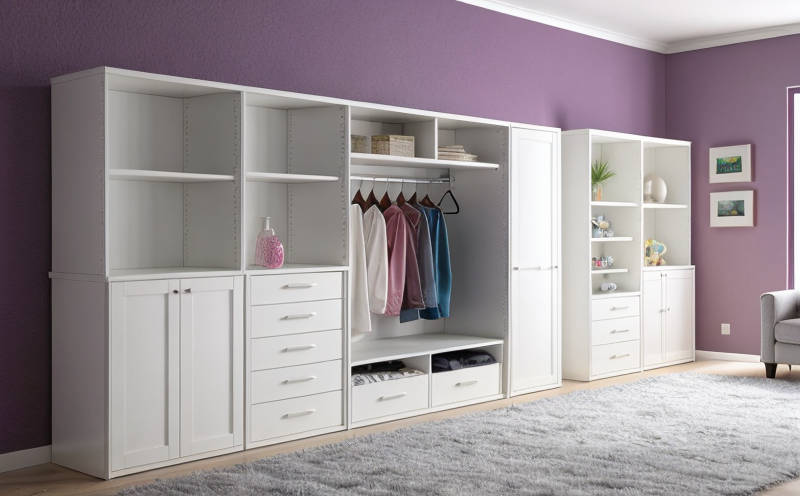ISO 7174 Stability of Storage Units Against Overturning Testing
The ISO 7174 standard is a critical benchmark for ensuring the structural integrity and safety of storage units in various applications. This test evaluates the stability of storage furniture against overturning forces, which can arise from the weight or pressure exerted by stored items. The primary goal is to ensure that storage units remain upright under expected loading conditions, thereby protecting both the contents and the unit itself.
The test procedure involves placing a storage unit in a specified orientation and applying a load at various points along its edges. The load is gradually increased until the unit begins to tilt or overturn. This process simulates real-world scenarios where items are stored improperly or where external forces, such as those from heavy objects, can cause instability.
The stability of storage units against overturning is crucial in many industries, including retail, warehousing, and manufacturing. In retail environments, for instance, unstable shelving can pose a significant safety hazard to both employees and customers. Warehouses with improperly secured units risk damage to valuable stock or injury to workers. In industrial settings, the integrity of storage furniture directly impacts operational efficiency and safety.
The ISO 7174 test is not just about compliance; it’s about ensuring that storage solutions are reliable and safe in high-stress environments. By adhering to this standard, manufacturers can demonstrate that their products meet or exceed international quality standards, thereby enhancing market credibility.
- Load Application: The load applied during the test is designed to simulate real-world conditions. This includes considering the weight of stored items and any additional forces that might be exerted on the unit.
- Testing Orientation: Storage units are tested in various orientations, including upright, tilted, and even partially loaded states, to ensure they remain stable under all conceivable scenarios.
- Data Collection: During the test, critical data points such as the angle of tilt before overturning, load capacity, and any structural damage are recorded. This information is crucial for quality control and continuous improvement processes.
The ISO 7174 Stability Test is particularly important in industries where storage units are subjected to high loads or where there’s a risk of tipping over. Retailers, for example, often use this test to ensure that their display units are safe and secure. Warehouses and logistics companies also rely on this standard to protect valuable inventory and minimize the risk of accidents.
The test results provide actionable insights into the structural integrity of storage furniture. Manufacturers can use these findings to identify areas for improvement in design and materials, ensuring that their products not only meet but exceed industry standards. This commitment to quality is essential for maintaining a positive reputation and gaining consumer trust.
Applied Standards
The ISO 7174 Stability of Storage Units Against Overturning Testing is part of a broader suite of standards designed to ensure the safety and reliability of storage furniture. This includes other relevant international standards such as ISO 3509 (Testing for load-bearing capacity of cabinets) and ISO 12286 (Safety of furniture—General requirements). Together, these standards provide a comprehensive framework for assessing the performance of storage units.
ISO 7174 specifically focuses on overturning stability, which is particularly important in environments where heavy loads are stored or where there’s a risk of tipping over. By adhering to this standard, manufacturers can ensure that their products meet stringent safety requirements and are suitable for use in various applications.
Industry Applications
The ISO 7174 Stability Test is widely applicable across multiple industries. In retail environments, it ensures that display units and shelving systems remain stable under expected loads. This helps to prevent accidents and damage to both the unit itself and its contents.
- Retail: Display units in stores are tested to ensure they can withstand the weight of products without toppling over.
- Warehousing: In warehouses, heavy-duty shelving is tested for stability under various loading conditions. This reduces the risk of accidents and protects valuable inventory.
- Manufacturing: Production lines often use storage units to hold parts or components. Testing ensures these units remain upright even when overloaded.
In addition to these industries, ISO 7174 is also applicable in residential settings where home furniture may be subject to high loads or uneven distribution of weight. By adhering to this standard, manufacturers can provide consumers with products that are both safe and reliable.
Competitive Advantage and Market Impact
The ISO 7174 Stability of Storage Units Against Overturning Testing provides manufacturers with a significant competitive advantage by ensuring their products meet or exceed international safety standards. This commitment to quality and safety enhances market credibility and consumer trust.
- Enhanced Safety: By adhering to this standard, manufacturers can ensure that their storage units are safe under all expected loading conditions.
- Increased Reputation: Compliance with ISO 7174 helps establish a reputation for quality and reliability, which is crucial in competitive markets.
- Customer Satisfaction: Consumers are more likely to purchase products from brands that demonstrate a commitment to safety and quality.
The test also has a positive impact on the market by reducing the risk of accidents and damage. This not only protects consumers but also reduces liability risks for manufacturers and retailers. By ensuring stability, ISO 7174 helps create safer environments in retail, warehouse, and manufacturing settings.





